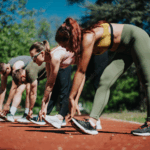
Weather can transform a routine competition into a test of limits. From the heat of a desert marathon to the chill of a high-altitude climb, athletes face challenges beyond training and tactics.
Temperature swings, humidity levels, wind gusts, precipitation, altitude shifts, and long-term climate trends all influence performance and safety. Understanding how weather affects athletic performance and the environmental factors affecting sports performance is essential for success in any sports environment.
In this article, you will learn:
- How heat and cold affect endurance, power output, and muscle function
- Why humidity makes hydration and cooling more complex
- The ways wind direction and speed influence speed, drafting, and gear choices
- How rain, snow, and ice alter traction and drive footwear decisions
- The impact of altitude on oxygen availability and acclimatization methods
- What rising temperatures and extreme events mean for future training and competition
- The latest wearables and AI tools that deliver real-time weather insights
- Mental resilience strategies to stay focused when conditions change
- Whether you compete on roads, trails, tracks, or slopes, this guide helps you adapt training, gear, and mindset to any forecast. We begin by exploring how temperature shapes endurance and power, then cover other environmental factors that drive sports outcomes.
Temperature: Impact on Endurance and Power
Athletes rely on thermoregulation to maintain performance. When temperatures stray from the optimal window, stamina and power output drop significantly. This section examines the impact of weather on sports performance by focusing on heat and cold stress.
Heat Stress and Performance Decline
High heat raises core temperature and accelerates dehydration, adding cardiovascular strain and cognitive fatigue. Studies show that every 1 °C deviation in WBGT above the ideal 7.5 to 15 °C range cuts endurance by 0.3 to 0.4 percent. In middle-distance to marathon races, heat stress can impair performance by 3 to 14 percent, adding minutes to finish times.
Optimal Performance Window
- WBGT: 7.5 °C to 15 °C
- Air temperature: 10 °C to 17.5 °C
Performance falls progressively outside these zones as athletes struggle with sweat rate, cardiovascular strain, and mental fatigue.
Cold Exposure and Muscle Function
Cold conditions trigger peripheral vasoconstriction to preserve core heat. This reduces blood flow and slows nerve conduction, which limits muscle contractile force and strength. About 27 percent of endurance events occur in cool settings, where athletes report stiffer muscles and slower reaction times.
Strength and Endurance in the Cold
- Muscle elasticity decreases
- Thorough warm-up routines and extra layers offset heat loss
By monitoring core temperature and applying heating strategies, athletes can compete closer to their peak even when ambient temperatures drop well below ideal ranges.
Humidity: Strain on Hydration and Thermoregulation
In warm environments, relative humidity above 40 percent reduces the gradient for sweat evaporation. At 100 percent humidity, no evaporation occurs, so sweat pools on the skin. Studies show trained runners at 31 °C and 61–71 percent relative humidity have higher body temperatures, faster heart rates, and reduced stroke volume compared to 23 percent humidity.
Athletes often report that training in 70 to 90 percent humidity feels tiring even when air temperatures match drier days. As humidity climbs, ratings of perceived exertion rise, making standard paces feel more draining. These effects of weather on athletes must be factored into training and competition plans.
Cardiovascular and Thermoregulatory Strain
- Core temperature rises progressively with humidity
- Heart rate increases and stroke volume drops
- Mean cycling time trials can slow by 3.4 percent at elevated absolute humidity
Hydration and Cooling Techniques
Fluid and Electrolyte Management
Begin sessions fully hydrated. Tailor sodium intake based on individual sweat rates to replace fluid and maintain plasma volume. Monitor body weight before and after workouts to estimate losses. Use urine color as an additional hydration cue. Athletes with medical conditions such as diabetes should consider managing diabetes while adjusting their insulin and fluid schedules in the heat.
Active Cooling Strategies
- Precooling with ice slurry or cooling vests lowers resting core temperature
- Per-cooling during exercise (ice packs, cold towels) helps sustain performance
- Apply per-cooling early in long sessions to offset thermal strain
- Heat acclimation over 5 to 8 days triggers earlier sweating onset and expands plasma volume
Wind: Influence on Speed, Strategy, and Trajectory
Tracking wind patterns lets coaches plan pacing, equipment choices, and in-game tactics. Wind direction and intensity influence speed and strategy. A tailwind reduces aerodynamic drag and boosts straight-line speed, while a headwind has the opposite impact. Crosswinds can push balls off course, requiring athletes to adjust posture and release points. Even moderate gusts of 5 m/s can change 100-meter sprint times by up to 0.2 seconds. This highlights another impact of weather on sports performance.
Tailwinds vs Headwinds
Tailwinds reduce the drag coefficient and lower the power requirements. In cycling time trials, a 3 m/s tailwind can improve average speed by 1 to 2 percent. Sprinters gauge wind before setting blocks to maximize push-off efficiency. Conversely, headwinds increase aerodynamic resistance and force athletes to expend extra energy to maintain pace. A 2 m/s headwind can add 0.1 to 0.2 seconds to 100-meter times.
Technical Adaptations in Windy Conditions
Drafting and Positioning
Drafting behind another rider or runner reduces drag by up to 30 percent. Pack formations in cycling and pace lines in road races help conserve energy when the wind is strong.
Equipment and Technique
- Lowered body posture shrinks the frontal area to cut drag
- Aerodynamic helmets, skinsuits, and wind-resistant apparel further reduce resistance
- In ball sports, players adjust launch angle and velocity to counter crosswind drift, ensuring accurate trajectories
Precipitation & Surface Conditions: From Rain to Snow
In rain-soaked settings, weather conditions and sports outcomes shift as surfaces become slippery, reducing traction and raising the risk of ankle sprains. Athletes adjust their stride and lean into each step to maintain balance.
- Cleat patterns with deeper channels shed water more effectively
- Water-resistant socks and low-profile shoes reduce slipping
Snow, Ice, and Equipment Adjustments
Snow or ice demands different gear and tactics. Heavy snow may hide surface irregularities, causing uneven footing. Ice can limit lateral cuts and change ball behavior.
Footwear and Traction Systems
- Short metal spikes or winter studs improve grip on hard snow
- Fiber-reinforced plate cleats resist freezing temperatures
- Gaiters and waterproof uppers keep feet dry and warm
By tailoring footwear and equipment, athletes preserve stability, control, and performance even when surfaces turn white or slick.
Altitude & Atmospheric Pressure: Oxygen Availability
At high elevations, the drop in barometric pressure reduces oxygen partial pressure in each breath. This limits arterial oxygen saturation and lowers maximal aerobic capacity. Athletes often feel short of breath, and fatigue sets in faster than at sea level. Altitude is a key environmental factor affecting sports performance, especially in endurance events.
Physiological Effects of High Altitude
When altitude exceeds about 2000 meters, available oxygen can fall by 20 percent. Lower SpO2 leads to reduced VO2max and endurance. To maintain power output, heart rate rises and ventilation increases. Over time, red blood cell production increases to carry more oxygen and buffer fatigue.
Acclimatization Strategies
Effective acclimatization often follows the live-high, train-low model:
- Live at 2000 to 2500 m to stimulate erythropoietin release and boost hemoglobin mass
- Train at lower altitudes to preserve workout intensity
- Ascend gradually over 7 to 14 days to adjust ventilation rate and fluid balance
Climate Change: Long-Term Environmental Shifts
Modern athletes must adapt to shifting baselines in temperature and weather extremes as climate change and sports intersect. Long-term trends in sports climate change and climate change and sport alter training windows, safety protocols, and event calendars.
Rising Heat and Athlete Health
Longer, intense heat waves challenge outdoor training. Under high-emissions scenarios, summer temperatures in London may rise 5 °C by 2050, increasing heat stress during major competitions. On hard courts, solar radiation can push surface temperatures from 41 °C ambient to nearly 49 °C. Heat stroke now occurs more often than non-heat cardiac events and remains a leading cause of athlete fatalities. Surveys of coaches reveal inconsistent heat protection measures and a demand for updated training on climate risks.
Extreme Weather Event Planning
Droughts may extend to 3 to 4 months by midcentury, while heavy rainfall and flash floods complicate scheduling in climate change sports scenarios. Convective storms carry a 1 percent risk of venue damage. Coaches emphasize flexible competition windows and robust emergency plans.
- Develop heat and drought contingency schedules
- Train staff in weather-related emergency protocols
- Integrate climate risk assessments into event planning
Tech & Gear Innovations: Wearables and Smart Solutions
Modern athletes rely on real-time weather data to adapt on the fly. Wearables and AI-driven forecasts support performance in diverse environments, improving how weather affects athletic performance.
Wearable Tech and Smart Clothing
Smart fabrics integrate temperature and moisture sensors directly into athletic clothing. These garments monitor core and skin temperature, sweat rate, and UV exposure. Data from embedded sensors syncs with mobile apps or wrist devices, offering instant alerts for heat stress or hypothermia risk. Key features include:
- Adaptive insulation based on body heat
- Moisture-wicking fibers with nano coatings
- Built-in biometric and environmental tracking
AI-Driven Weather Forecasting
Machine learning models process satellite, radar, and local sensor data to generate microclimate forecasts. These AI-powered tools predict temperature shifts, wind gusts, and precipitation at training sites in minutes. Athletes and coaches get tailored alerts to adjust pacing, hydration, and gear choices. By integrating forecast APIs with wearable dashboards, they gain seamless decision support on the go.
Mental Resilience: Strategies for Unpredictable Weather
Athletes must account for weather variability to stay focused when conditions shift. Developing mental resilience supports adaptability in any sports environment. Visualization and adaptability practices help athletes respond calmly to heat, cold, wind, or rain. Including varied-weather sessions in training plans boosts confidence and flexible thinking.
Visualization and Adaptability
Guided imagery lets athletes rehearse scenarios across heat, cold, wind, or rain. By mentally stepping through each situation, they learn to shift tactics and remain calm. Training plans that include sessions in varied weather boost confidence and promote flexible thinking.
Mental Toughness Practices
Core mental skills include goal setting and positive self-talk. Short breathing drills restore focus after an unexpected storm. If work stalls, moving indoors and applying the same mindset routine preserves intensity. Consistent practice of these skills helps athletes face any weather with confidence.
Conclusion
The weather is both an opponent and an ally in modern athletics. By understanding how temperature, humidity, wind, precipitation, altitude, and long-term climate trends shape performance, athletes and coaches can make informed decisions on training, gear, and race strategy. Key takeaways include:
- Monitor temperature and WBGT to set optimal training and racing windows
- Tailor hydration and cooling methods to humidity levels
- Use drafting, aerodynamic positions, and gear to combat wind
- Select specialized footwear and traction systems for rain, snow, or ice
- Employ live-high, train-low protocols to adapt to altitude
- Integrate climate change and sports strategies as heat and extreme events rise
- Leverage wearables and AI-driven weather forecasts for real-time insights
- Build mental resilience with varied-weather sessions and visualization techniques
This guide equips you to anticipate changes, adjust your approach on the fly, and protect both performance and safety. Weather will always introduce unpredictability, but with the right knowledge and tools, you can turn environmental challenges into competitive advantages. Embrace weather as part of the elements game and push your limits in any forecast.

 Steelersforever.org
Steelersforever.org






